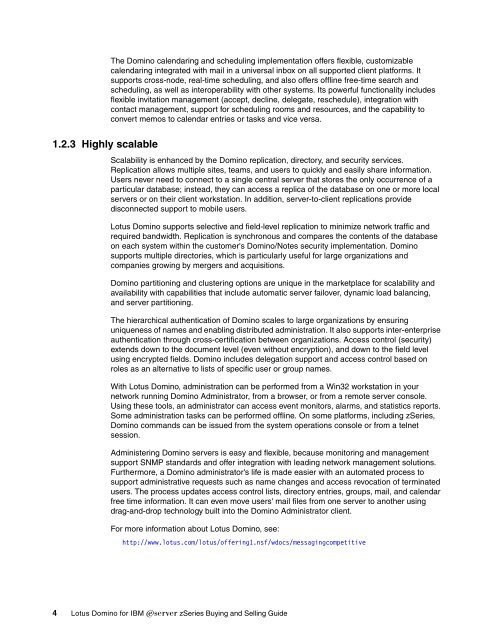Download PDF (1 MB) - IBM Redbooks
Download PDF (1 MB) - IBM Redbooks
Download PDF (1 MB) - IBM Redbooks
Create successful ePaper yourself
Turn your PDF publications into a flip-book with our unique Google optimized e-Paper software.
1.2.3 Highly scalable<br />
The Domino calendaring and scheduling implementation offers flexible, customizable<br />
calendaring integrated with mail in a universal inbox on all supported client platforms. It<br />
supports cross-node, real-time scheduling, and also offers offline free-time search and<br />
scheduling, as well as interoperability with other systems. Its powerful functionality includes<br />
flexible invitation management (accept, decline, delegate, reschedule), integration with<br />
contact management, support for scheduling rooms and resources, and the capability to<br />
convert memos to calendar entries or tasks and vice versa.<br />
Scalability is enhanced by the Domino replication, directory, and security services.<br />
Replication allows multiple sites, teams, and users to quickly and easily share information.<br />
Users never need to connect to a single central server that stores the only occurrence of a<br />
particular database; instead, they can access a replica of the database on one or more local<br />
servers or on their client workstation. In addition, server-to-client replications provide<br />
disconnected support to mobile users.<br />
Lotus Domino supports selective and field-level replication to minimize network traffic and<br />
required bandwidth. Replication is synchronous and compares the contents of the database<br />
on each system within the customer's Domino/Notes security implementation. Domino<br />
supports multiple directories, which is particularly useful for large organizations and<br />
companies growing by mergers and acquisitions.<br />
Domino partitioning and clustering options are unique in the marketplace for scalability and<br />
availability with capabilities that include automatic server failover, dynamic load balancing,<br />
and server partitioning.<br />
The hierarchical authentication of Domino scales to large organizations by ensuring<br />
uniqueness of names and enabling distributed administration. It also supports inter-enterprise<br />
authentication through cross-certification between organizations. Access control (security)<br />
extends down to the document level (even without encryption), and down to the field level<br />
using encrypted fields. Domino includes delegation support and access control based on<br />
roles as an alternative to lists of specific user or group names.<br />
With Lotus Domino, administration can be performed from a Win32 workstation in your<br />
network running Domino Administrator, from a browser, or from a remote server console.<br />
Using these tools, an administrator can access event monitors, alarms, and statistics reports.<br />
Some administration tasks can be performed offline. On some platforms, including zSeries,<br />
Domino commands can be issued from the system operations console or from a telnet<br />
session.<br />
Administering Domino servers is easy and flexible, because monitoring and management<br />
support SNMP standards and offer integration with leading network management solutions.<br />
Furthermore, a Domino administrator's life is made easier with an automated process to<br />
support administrative requests such as name changes and access revocation of terminated<br />
users. The process updates access control lists, directory entries, groups, mail, and calendar<br />
free time information. It can even move users' mail files from one server to another using<br />
drag-and-drop technology built into the Domino Administrator client.<br />
For more information about Lotus Domino, see:<br />
http://www.lotus.com/lotus/offering1.nsf/wdocs/messagingcompetitive<br />
4 Lotus Domino for <strong>IBM</strong> Eserver zSeries Buying and Selling Guide
















